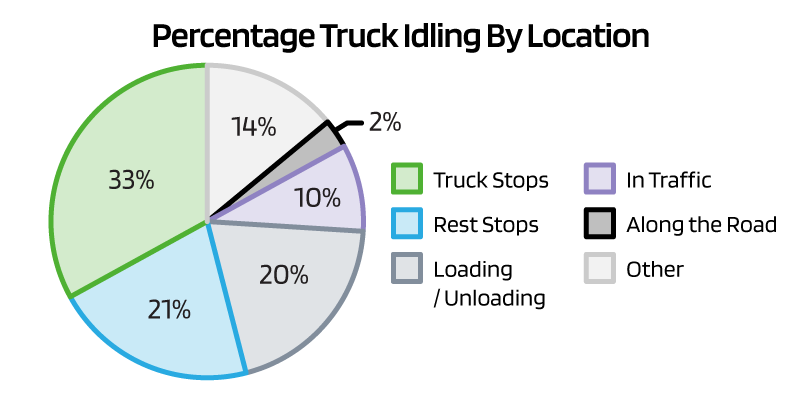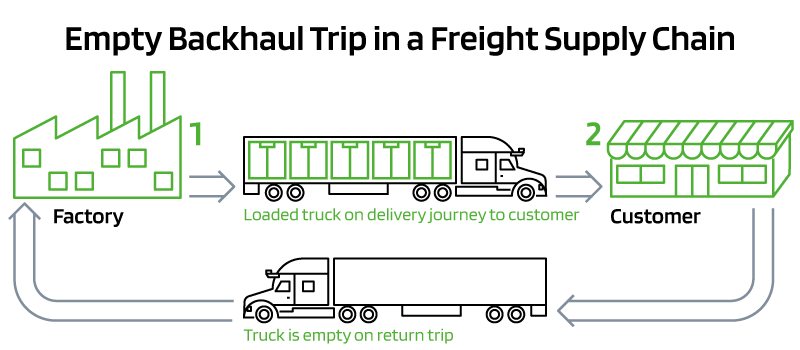There has been a notable volume of recent discussion and anticipation in the autonomous trucking industry about the potential for technology to have direct positive benefits both environmentally and socially. TuSimple’s mission is to make long-haul trucking significantly safer, more reliable, efficient, and environmentally friendly. To validate our mission, we completed studies with the University of California San Diego, UPS North America Air Freight, Geotab, and Smartway, and have an upcoming research partnership with Goodyear. Our research so far indicates that autonomous trucking can lead to increased fuel efficiency, safety, and reduced greenhouse gas emissions.
Environmental Impact
Powertrains, Fuel, and Emissions. Autonomous vehicles can offset some of the EPA’s 2019 findings that medium and heavy-duty trucks contribute 24% of annual U.S. transportation greenhouse gas emissions. For example, autonomous trucks can reduce Scope 1 greenhouse gas (GHG) emissions by decreasing empty trailer hauling (deadhead) and idling just by bypassing truck stops and rest stops.Additionally, the speed monitoring capability of autonomous trucks ensures fewer fluctuations in speed limit, which also reduces fuel consumption and maintenance costs.
Tires. The environmental impact of a tire resonates throughout the supply chain; from its production, use, and end-of-life disposal. Such environmental impacts have repercussions for our air, ocean, and land. The motion planning capability of autonomous trucks minimizes unnecessary driving maneuvers like lane changes and braking so there’s less wear and tear on tires. This increase in tire longevity in turn minimizes health-related risks to humans and the environment from tire-related pollution.
Speed and Driving Behavior Monitoring. Similar to less wear on tires, an autonomous truck’s maneuvering and speed monitoring capability allows for better speed and driving behavior. Speed limiting directly reduces crashes. Additionally, a 55-60% reduction in unsafe events, including harsh braking and acceleration, by drivers of sleeper cabs (i.e. long-haul drivers) has been shown to lead to a 5.4% gain in fuel economy.
Idling. Along with rest stops and truck stop breaks, which make up for 54% of idling time, many truckers also idle their engines overnight for heating, cooling, and electricity for appliances. With long haul trucking, this might be 28 hours per week at almost 0.8 gallons per hour. Additionally, up to 54% of idling by heavy-duty trucks could be eliminated through self-driving capabilities, as autonomous trucks do not go to truck stops and rest stops.

(The American Transportation Research Institute)
Deadhead. Deadhead miles, or “backhaul,” are empty miles that are driven without a load. According to the National Private Truck Council, up to 28% of private fleets’ miles qualified as deadhead. Most commonly, this happens when carriers opt to make a deadhead trip rather than take on a cheap load or when drivers need to return to their point of origin.

Deadhead results in unnecessary pollution: GHG emissions, fuel consumption, truck wear and tear, all exacerbated by a lack of associated economic activity. Autonomous trucks can’t completely eliminate deadhead miles, but they do eliminate the need to return a driver to their point-of-origin. One social benefit of this is that drivers should be able to spend more time with their families. Bundling shipments that would have been handled by multiple drivers into a job for a single driver has the potential to reduce empty miles from the industry standard of 35% to 19%. If the trucking industry as a whole can achieve the same efficiency improvements, it would reduce CO2 emissions by 32 million metric tons.
Social Impact
Safety. Speeding and behavior monitoring features of autonomous trucking also directly improves public safety. TuSimple’s trucks can achieve this through its autonomous driving technology: perception, motion planning, control, and mapping. These components leverage data and information from TuSimple’s proprietary sensor system that includes cameras, LiDARs, radars, and ultrasonic sensors. Trip planning and speed monitoring features mean that the vehicles’ behaviors are much more easily predictable by the human drivers around them, predictability being a key factor in collision avoidance. In 2018, 32.3% of fatal crashes involving large trucks (trucks over 10,000 lbs gross vehicle weight rating), recorded at least one driver-related factor. Of these crashes, 5.3% were due to driver distraction, 4.4% due to driver impairment and 6.8% due to speeding. The leading driver distraction-related factor was impairment from being under the influence of alcohol, drugs, or medications, followed by driver fatigue and sleep deprivation. Theoretically, in an autonomous vehicle, given the extraction of the driver from the truck, driver distraction and driver impairment should be completely eliminated while driver speeding will be eliminated to constant speed monitoring and control of the autonomous truck.
Public Health. In addition to air-pollution-related asthma, other health impacts of traffic-related air pollution include cardiovascular deaths and illness from both short-term and long-term exposure to traffic-related air pollution, lung cancer in people who have never smoked and breast cancer in post-menopausal women.
TuSimple continues to identify additional ways to reduce emissions generated by our fleet. This includes improving the wear on parts, reducing tire wear, minimizing the output of CO2, particulate matter, and NOx through reduced idling, and increasing fuel efficiency, off-peak trip starts, and speed optimization.
Food Waste and Food Insecurity. In 2017, the United States generated approximately 206 billion pounds of food waste, which equates to 30-40% of its food supply. As food rots in landfills, it emits methane, a GHG 28 to 36 times more potent than carbon emitted by passenger vehicles. Food insecurity, on the other hand, is the disruption of food intake or feeding patterns due to lack of money or other resources. It can affect people from all socioeconomic brackets, but is most common in impoverished neighborhoods. As such, food waste has the profound social implication of the lost opportunity to reduce food insecurity.
TuSimple believes that autonomous trucks have the potential to solve the challenges of food waste. By collaborating with food industry leaders including McLane and Giumarra (who supports over 2,000 growers), we learned that autonomous trucking can greatly reduce shipping times by 42%. This extends the shelf life of produce and can reduce prices, so TuSimple and partners have the opportunity to provide greater access to healthier food in communities located in “food deserts” and thereby improve the overall health of the community.
Along with addressing food waste, we believe that our autonomous trucks can reduce food insecurity by providing a safe and efficient way to distribute food to the organizations that serve those most in need. Currently, we are partnered105 with the Community Food Bank of Southern Arizona106 in providing both food donations and freight transportation.

As of December 31st, 2021, we have successfully delivered more than 3.5 million pounds of food, or 2.7 million meals, to communities in need in partnership with the Community Food Bank of Southern Arizona and look forward to continuing our partnership with them.
Human Trafficking. Human trafficking is a global problem in which people are coerced into commercial sex acts or labor against their will. This industry generates profits amounting to an estimated $150 billion annually, worldwide. There are an estimated 40 million victims of human trafficking globally, including thousands of children and adults in the United States. The scale of this crime calls for an equally sizable response. Truckers Against Trafficking (TAT) reported that over the past decade, truck drivers have made more than 2,000 calls to their hotline, helping to assist more than 600 likely cases and identify more than 1,000 potential victims.
TuSimple is the first autonomous trucking company to sign on as a sponsor to TAT. As part of our commitment to combatting human trafficking, Laura Cyrus, TAT’s Director of Corporate Engagement, recently spoke to our employees about what they can do both on the road and in everyday situations to spot signs of human trafficking and call the TAT hotline. We want to become a part of the solution. Additionally, all of TuSimple’s safety drivers and AV system operators are required to complete the TAT training program on identifying human trafficking. As of January 2022, we have trained and certified over 60 safety drivers and AV system operators for TAT.
TuSimple offers a multi-faceted solution to address environmental challenges such as greenhouse gas emissions and fuel wastage, as well as socioeconomic issues including public health, food waste and insecurity, and human trafficking. We believe our SAE Level 4 autonomous trucks will not only make the roads safer for all, but also contribute meaningfully towards the trucking industry’s environmental and social impact.
For more information, please access the full Environmental and Social Impacts of Autonomous Trucking White Paper Here.

